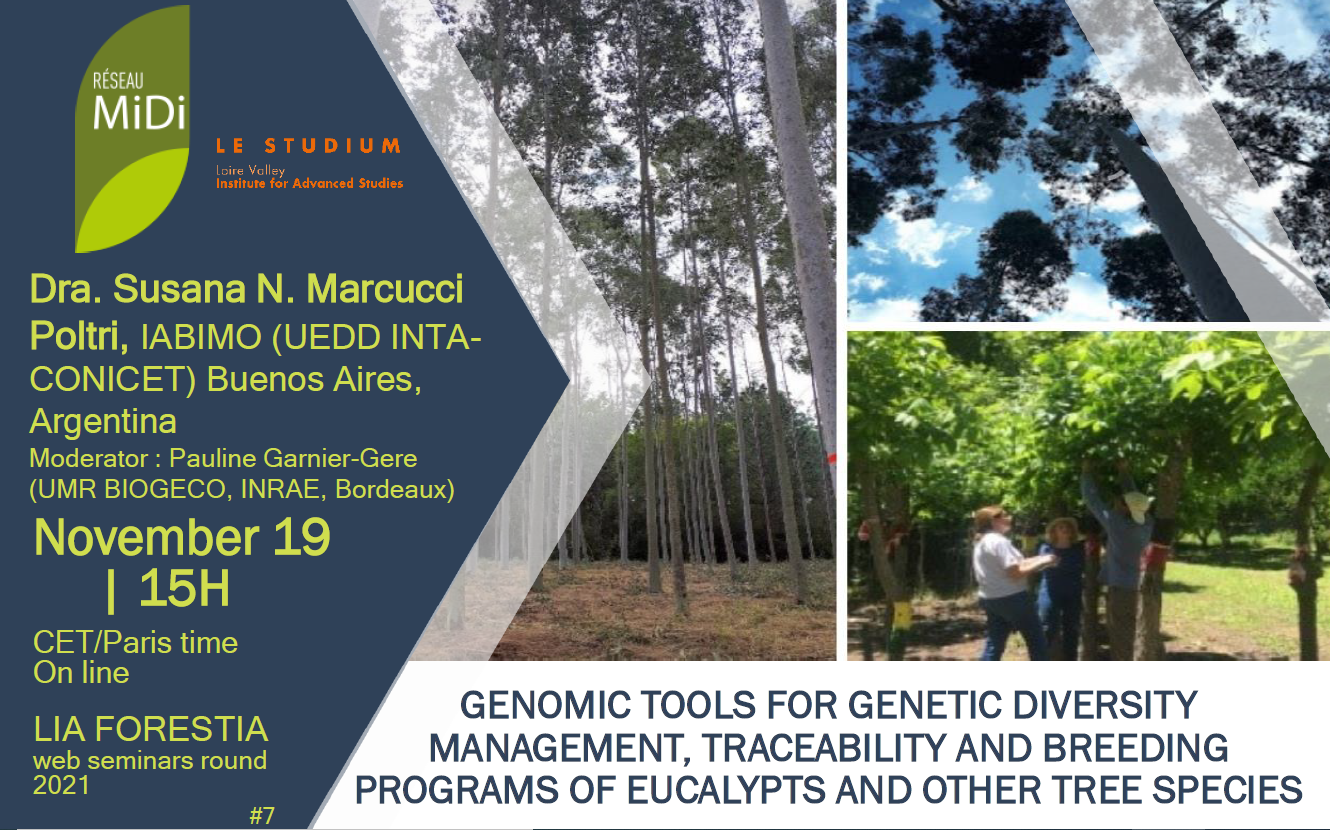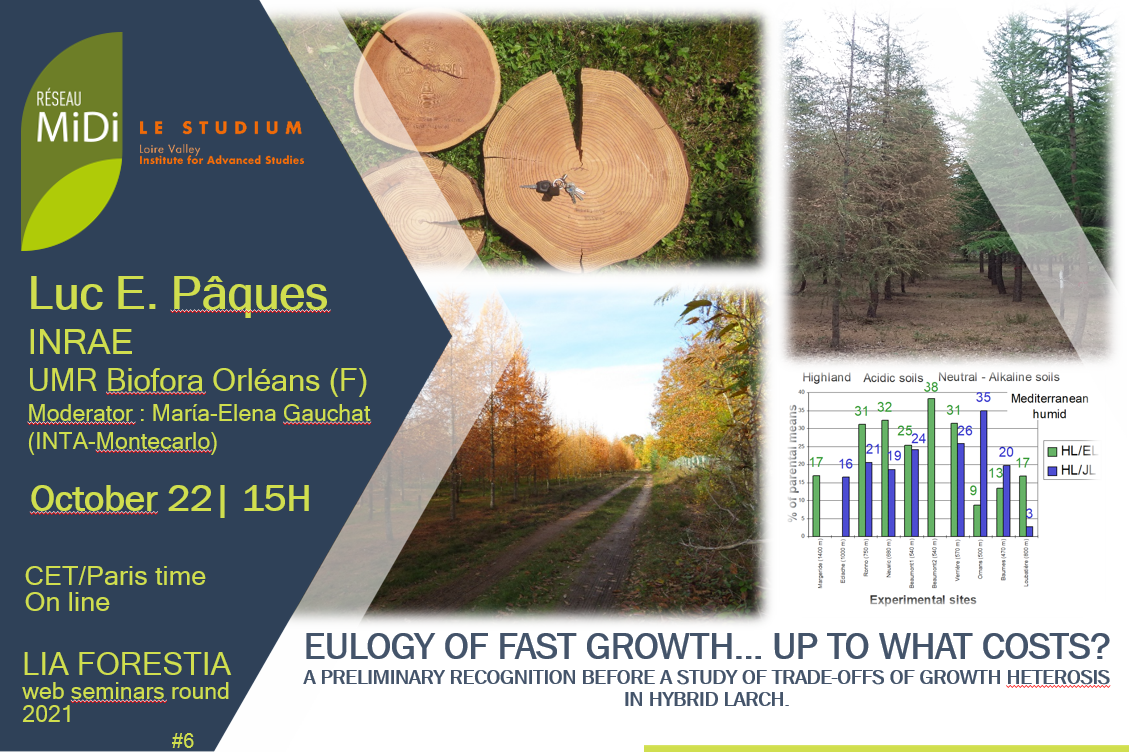Notice
#5 Relationships between wood traits and drought resistance in Eucalyptus spp: evidences and open questions
- document 1 document 2 document 3
- niveau 1 niveau 2 niveau 3
Descriptif
Round of FORESTIA web seminars
SEMINAR # 5
“Relationships between wood traits and drought resistance in Eucalyptus spp: evidences and open questions”
Dr. María Elena Fernández,
(CONICET-INTA IPADS, LIA Forestia, Tandil, Argentina)
October 8 at 15h (CET/Paris time)
The International Associated Laboratory FORESTIA starts in 2021 a new round of short seminars aimed at stimulating the scientific comunication among its members, as well as between them and other international laboratories. These seminars are a new opportunity for the FORESTIA scientists to present and discuss their objectives, research work and results on adaptation of forest ecosystems to global changes.
Seminar #5 by María Elena Fernández, (CONICET-INTA IPADS, Tandil, Argentina).
Abstract
Eucalyptus is one of the main forestry genus with more than 20 million ha. planted worldwide, in addition to the native forests in Oceania, formed by more than 700 species growing in very diverse environments. Although there is broad knowledge about ecophysiological traits of eucalypts, response to silviculture (of the few planted species) and wood anatomy and technological properties related to industrial uses, we know very little about the relationships between wood anatomy and function in this genus, and their implications for drought resistance. Moreover, the wood of eucalypts is complex, with mostly solitary vessels surrounded and connected to vasicentric tracheids, fiber tracheids and parenchyma cells, all immersed in a matrix of fibers. The hydraulic functioning of this tissue cannot be understood in terms of the current knowledge of wood hydraulic function developed mostly from conifers and broadleaves with grouped vessels. We present our results related to this topic developed from commercial eucalipt plantations in Argentina and Spain; we compare them to recent (and quite opposite) results from native forests in Australia, and we delineate some of the open questions we are exploring to contribute to the adaptive management and genetic improvement of this genus in a framework of climate change.
Moderator :Anne-Sophie Sergent (Moderator) - INTA Bariloche, Argentina
Dans la même collection
-
#7 Genomic tools for genetic diversity management, traceability and breeding programs of eucalypts …
Our group works on the development and application of different genomic tools to support INTA´s forest and fruit breeding programs distributed throughout Argentina.
-
#6 Eulogy of fast growth… up to what costs? A preliminary recognition before a study of trade-offs…
Round of FORESTIA web seminars SEMINAR # 6 “Eulogy of fast growth… up to what costs? A preliminary recognition before a study of trade-offs of growth heterosis in hybrid larch.” Luc E.
-
-
#3 The challenge of the integrating the adaptive and technological value of wood in a changing clim…
Round of FORESTIA web seminars SEMINAR # 3 The challenge of the integrating the adaptive and technological value of wood in a changing climate Guillermina Dalla-Salda (INTA Bariloche
-
#1 Deciphering tree response to a changing climate
Round of FORESTIA web seminars SEMINAR # 1 Deciphering tree response to a changing climate Where are we? where do we go? a case study: southern beeches of Patagonia María Verónica
Sur le même thème
-
-
#6 Eulogy of fast growth… up to what costs? A preliminary recognition before a study of trade-offs…
Round of FORESTIA web seminars SEMINAR # 6 “Eulogy of fast growth… up to what costs? A preliminary recognition before a study of trade-offs of growth heterosis in hybrid larch.” Luc E.
-
#7 Genomic tools for genetic diversity management, traceability and breeding programs of eucalypts …
Our group works on the development and application of different genomic tools to support INTA´s forest and fruit breeding programs distributed throughout Argentina.
-
#3 The challenge of the integrating the adaptive and technological value of wood in a changing clim…
Round of FORESTIA web seminars SEMINAR # 3 The challenge of the integrating the adaptive and technological value of wood in a changing climate Guillermina Dalla-Salda (INTA Bariloche
-
S2-Elevation dependent warming and climate change in the mountains: strengths and uncertainties
Elevation dependent warming and climate change in the mountains: strengths and uncertainties Elisa Palazzi (Co-Chair of the Collaborative programmes of ECRA on Hydological Cycle; ISAC-CNR, Italy)
-
S3- Adaptation of wine growing to climate change and water management
Adaptation of wine growing to climate change and water management Nina Graveline (INRAE, Montpellier)
-
S1- Welcoming by the MiDi network and Introducing speech
Welcoming by the MiDi network - Stéphanie Bankhead (University of Orleans, LBLGC; co-director of the network)
-
S2- Panel Discussion on “Hydrometeorological Extremes – Prevision and management of impacts”
Panel Discussion on “Hydrometeorological Extremes – Prevision and management of impacts” with Peter Braesicke (chair of ECRA network, KIT, Karlsruhe), Isabelle La Jeunesse, Elisa Palazzi,
-
S1- Horizon Europe: EU funded research and Community building in the area of climate and weather ex…
Horizon Europe: EU funded research and Community building in the area of climate and weather extreme events Philippe Quevauviller (Innovation and Industry for Security, DG HOME, European Commission,
-
S3- Wood, tree-ring and hydraulic studies of adaptation to drought in forest trees
Wood, tree-ring and hydraulic studies of adaptation to drought in forest trees Philippe Rozenberg (BIOFORA INRAE, Orléans)
-
S2-Dynamics of hydrometeorological extremes in Southern Germany and the Alps
Dynamics of hydrometeorological extremes in Southern Germany and the Alps Ralf Ludwig (Co-Chair, of the Collaborative programmes of ECRA on Hydological Cycle; LMU, Germany)
-
S1- Opening of the symposium : The state of global climate change
Opening of the symposium : The state of global climate change Hervé Le Treut (Dir. IPSL, Paris)














